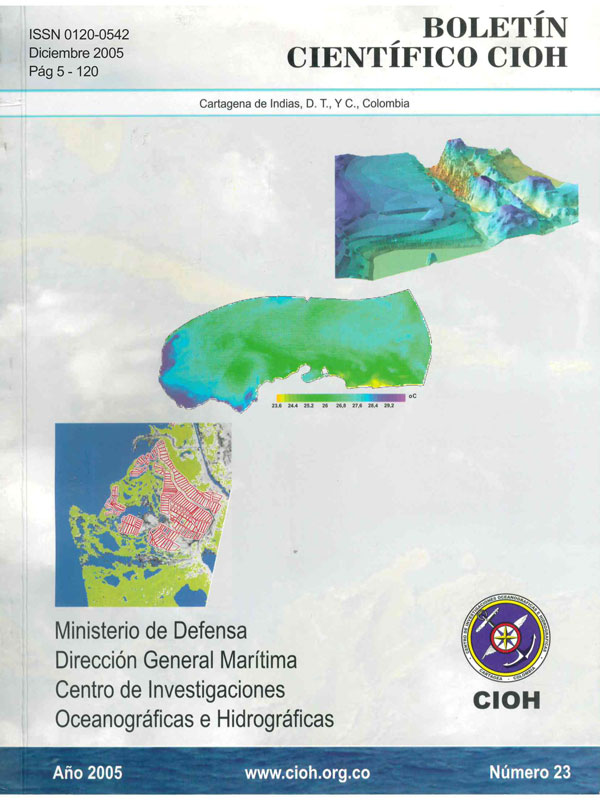Análisis del uso del suelo por acuicultura en el delta del Canal del Dique entre 1986 y 2003 (Caribe colombiano)
DOI:
https://doi.org/10.26640/22159045.142Palabras clave:
Manglar, Acuicultura, Imágenes satelitales (Landsat y Spot), Colombia (Costa Caribe de), Dique (Canal del)Resumen
Al sur de la ciudad de Cartagena de Indias (litoral Caribe de Colombia) se encuentra el Canal del Dique, brazo natural canalizado del río Magdalena que forma un delta de tres bocas. Este delta, colonizado por manglares donde dominan Rhizophora mangle, Avicennia germinans, Laguncularia racemosa y Pelliciera rhizophorae, fue explotado tradicionalmente por mucho tiempo. Las zonas de manglares fueron taladas para usos como producción de madera para construcción y carbón de madera. Adicionalmente, a partir de los años ochenta predominó una actividad agroindustrial con la instalación de infraestructura acuícola (piscinas) para el levante de camarón Penaeus vannamei y P. stylirostris con miras a su exportación. El desarrollo de la industria acuícola indujo una fuerte presión sobre el sector del Canal del Dique transformando radicalmente el paisaje del delta.
Los autores se proponen mostrar, gracias a un seguimiento satelital utilizando las imágenes Landsat TM, ETM y Spot HRV como HRG (18 imágenes en total), la evolución del uso del suelo del delta entre 1986 y 2003. La interpretación de las imágenes permitió cartografiar la dinámica de las superficies convertidas en infraestructuras acuícolas y la alteración de la hidrología del delta (desviación de canales preexistentes, apertura de nuevos canales, drenaje de ciénagas). La crisis de la industria acuícola debida a la aparición en las fincas camaroneras del virus del síndrome de Taura, se presenta desde 1992 persistiendo hasta 1997. Los resultados del estudio tienden a desmentir la aserción común según la cual el desarrollo de la industria acuícola se haría sobre el manglar. En la zona estudiada, principalmente la superficie de lagunas y salares se convirtieron en infraestructuras acuícolas.
La teledetección espacial resultó ser una herramienta eficaz para llevar a cabo un seguimiento satelital del desarrollo de la acuicultura en el delta de una zona tropical, el Canal del Dique. La crónica de imágenes Landsat (TM y ETM) y de Spot (HRV y HRG) utilizada permitió cartografiar de forma precisa, anual o bianualmente, la dinámica de la superficie del manglar así como la extensión de las piscinas acuícolas. Las imágenes satelitales, por su carácter repetitivo, sinóptico y multiespectral, se constituyen en un instrumento fundamental de vigilancia del litoral.
Descargas
Referencias
Álvarez León R. y Polanía, J. (1996). Los manglares del Caribe colombiano: síntesis de su conocimiento. Revista de la Academia colombiana de Ciencias Exactas, Físicas y Naturales, 20, (78), pp. 447-464.
CARDIQUE (1998). Diagnóstico, zonificación y planificación estratégica de las área de manglar de Bolívar. Cartagena de Indias.
Donato Rondon J. (1998). Los sistemas acuáticos de Colombia: síntesis y revisión, Guerrero (éd.), Sánchez, Alvarez y Escobar (comp.,) Una Aproximación a los Humedales en Colombia, UICN, Fondo FEN, Santa Fe de Bogotá, 163 p.
Kergomard C. (2000). Pratique des corrections atmosphériques en télédétection utilisation du logiciel 5S-PC, Cybergeo, (181): http://www.cybergeo.presse.fr.
Leblanc F. (1983). Informe final estudio geológico litoral Caribe colombiano, CIOH, InformeTécnico, Cartagena, 26 p.
Leblanc F. (1985). Approche morphologique et sédimentologique du delta du Dique, côte caraïbe de la Colombie. Thèse de 3ème cycle, Université de Bordeaux I, 244 p.
Legros Th. (1992). Puerto Chacho et les premiers céramistes américains – Nouvelles données sur le Formatif Ancien du littoral caraïbe de Colombie. Thèse de 3 ème cycle, Université de Paris Panthéon Sorbonne, UER d’Histoire de l’Art etArchéologie, Centre de Recherche enArchaéologie Précolombienne, 523 p.
Lemaître E. (1982). Historia del Canal del Dique.Sus peripecias y vicisitudes. ConstructoraSanz & Cía. Cobe Ltda, 64 p.
Mispan M. R. y P. M. Mather (1997). Multi - Sensor Radiometric Correction: A Case Study from Malaysia. 18th Asian Conference on Remote Sensing, Malaysia, October 20-24, http://www;gisdeveloppement.net/aars/acrs/1997/ps2/ps4022pf.htm
Muller E. (1993). Evaluation and correction of angular anistropic effects in multidate SPOT and Thematic Mapper data, Remote Sensing of Environment, (45), pp. 295-309.
Pérez - Arbelaez E. (1978). Plantas útiles de Colombia. Bogotá, Arco, 831 p.
Reichel - Dolmatoff G. (1965). Colombia: Ancient Peoples and Places, London, Thames et Hudson, 231 p. + 65 pl.
Sánchez-Páez H., G. A. Ulloa-Delgado y H.A. Tavera - Escobar (2004), Manejo integral de manglares por comunidades locales Caribe deColombia, Unión Gráfica Ltda., Bogotá, junio 2004, 335 p.
Sánchez-Páez H. y R. Álvarez-León (2000). Conservación y Manejo para el Uso Múltiple y Desarrollo de los Manglares en Colombia, Proyecto PD 171/91 Rev. 2 Fase II (Etapa 2), Ministerio del Medio Ambiente / OIMT.Santa Fe de Bogotá D. C. (Colombia), 511 p.
Tibaquira L., D. Yanine - Díaz y E. Daza (1980). Aspectos técnicos generales de carácter evaluativo y conceptual sobre el ecosistema de manglar de las zonas de Ciénaga Grande yCanal del Dique en el litoral Atlántico/, Bogotá D. C., INDERENA, Subgerencia deFomento de Bosques Agua y Suelos, 51 p + anexos.
Vermote E., D. Tandré, J. L. Deuzé J. L., Herman M. and J. J. Morcrette (1997). Second Simulation of the satellite Signal in theSolar Spectrum (6S), Villeneuve d’Ascq, Laboratoire d’Optique Atmosphérique Ed., 218 p.
Viña G. (1990). Impacto del dragado en las zonas del manglar del Canal del Dique, Ríos y costas, 1, (1), pp. 7-17.
Winograd M. (1987). Mangroves de Colombie: Particularités biologiques et économiques. Gaussenia, (3), pp. 11- 43.
Descargas
Publicado
Número
Sección
Licencia
Reconocimiento — Debe reconocer adecuadamente la autoría, proporcionar un enlace a la licencia e indicar si se han realizado cambios<. Puede hacerlo de cualquier manera razonable, pero no de una manera que sugiera que tiene el apoyo del licenciador o lo recibe por el uso que hace.
NoComercial — No puede utilizar el material para una finalidad comercial.
SinObraDerivada — Si remezcla, transforma o crea a partir del material, no puede difundir el material modificado.
No hay restricciones adicionales — No puede aplicar términos legales o medidas tecnológicas que legalmente restrinjan realizar aquello que la licencia permite.



